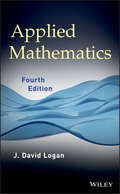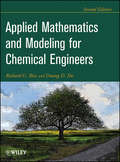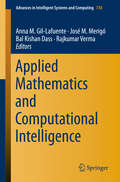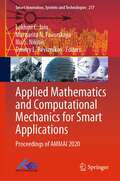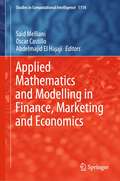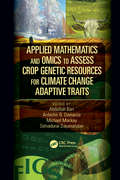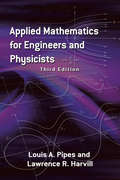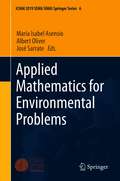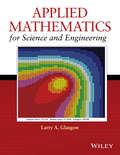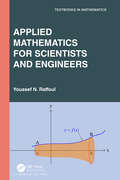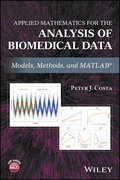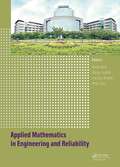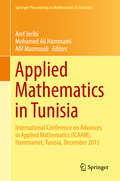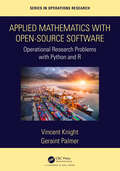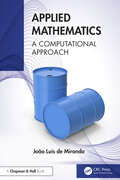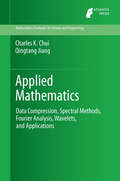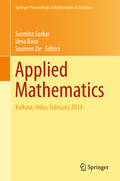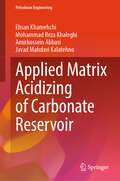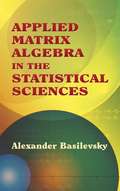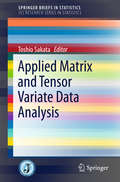- Table View
- List View
Applied Mathematics
by J. David LoganApplied Mathematics, Fourth Edition is a thoroughly updated and revised edition on the applications of modeling and analyzing natural, social, and technological processes. The book covers a wide range of key topics in mathematical methods and modeling and highlights the connections between mathematics and the applied and natural sciences. The Fourth Edition covers both standard and modern topics, including scaling and dimensional analysis; regular and singular perturbation; calculus of variations; Green's functions and integral equations; nonlinear wave propagation; and stability and bifurcation. The book provides extended coverage of mathematical biology, including biochemical kinetics, epidemiology, viral dynamics, and parasitic disease. In addition, the new edition features:Expanded coverage on orthogonality, boundary value problems, and distributions, all of which are motivated by solvability and eigenvalue problems in elementary linear algebra. Additional MATLAB® applications for computer algebra system calculations. Over 300 exercises and 100 illustrations that demonstrate important concepts. New examples of dimensional analysis and scaling along with new tables of dimensions and units for easy reference. Review material, theory, and examples of ordinary differential equations. New material on applications to quantum mechanics, chemical kinetics, and modeling diseases and viruses. Written at an accessible level for readers in a wide range of scientific fields, Applied Mathematics, Fourth Edition is an ideal text for introducing modern and advanced techniques of applied mathematics to upper-undergraduate and graduate-level students in mathematics, science, and engineering. The book is also a valuable reference for engineers and scientists in government and industry.
Applied Mathematics
by Pearson Custom PublishingApplied Mathematics shows students how mathematics arises naturally from everyday situations through hands-on, real-life activities and accompanying practice exercises. These activities help students make the connection between algebra, geometry, and statistics.
Applied Mathematics And Modeling For Chemical Engineers: Solutions Manual (Chemical Engineering Ser.)
by Duong D. Do Richard G. RiceThis Second Edition of the go-to reference combines the classical analysis and modern applications of applied mathematics for chemical engineers. The book introduces traditional techniques for solving ordinary differential equations (ODEs), adding new material on approximate solution methods such as perturbation techniques and elementary numerical solutions. It also includes analytical methods to deal with important classes of finite-difference equations. The last half discusses numerical solution techniques and partial differential equations (PDEs). The reader will then be equipped to apply mathematics in the formulation of problems in chemical engineering. Like the first edition, there are many examples provided as homework and worked examples.
Applied Mathematics and Computational Intelligence (Advances In Intelligent Systems And Computing #730)
by José M. Merigó Anna M. Gil-Lafuente Bal Kishan Dass Rajkumar VermaThis book gathers selected papers presented at the conference of the Forum for Interdisciplinary Mathematics (FIM), held at Palau Macaya, Barcelona, on 18 to 20 November, 2015. The event was co-organized by the University of Barcelona (Spain), the Spanish Royal Academy of Economic and Financial Sciences (Spain) and the Forum for Interdisciplinary Mathematics (India).
Applied Mathematics and Computational Intelligence: ICAMCI-2020, Tripura, India, December 23–24 (Springer Proceedings in Mathematics & Statistics #413)
by Oscar Castillo Dipak Kumar Jana Uttam Kumar BeraThis book contains select papers presented at the International Conference on Applied Mathematics and Computational Intelligence (ICAMCI-2020), held at the National Institute of Technology Agartala, Tripura, India, from 19–20 March 2020. It discusses the most recent breakthroughs in intelligent techniques such as fuzzy logic, neural networks, optimization algorithms, and their application in the development of intelligent information systems by using applied mathematics. The book also explains how these systems will be used in domains such as intelligent control and robotics, pattern recognition, medical diagnosis, time series prediction, and complicated problems in optimization. The book publishes new developments and advances in various areas of type-3 fuzzy, intuitionistic fuzzy, computational mathematics, block chain, creak analysis, supply chain, soft computing, fuzzy systems, hybrid intelligent systems, thermos-elasticity, etc. The book is targeted to researchers, scientists, professors, and students of mathematics, computer science, applied science and engineering, interested in the theory and applications of intelligent systems in real-world applications. It provides young researchers and students with new directions for their future study by exchanging fresh thoughts and finding new problems.
Applied Mathematics and Computational Mechanics for Smart Applications: Proceedings of AMMAI 2020 (Smart Innovation, Systems and Technologies #217)
by Lakhmi C. Jain Margarita N. Favorskaya Ilia S. Nikitin Dmitry L. ReviznikovThis book presents best selected research papers presented at the Thirteenth International Conference on Applied Mathematics and Mechanics in the Aerospace Industry (AMMAI 2020), held from September 6 to September 13, 2020, at the Alushta Health and Educational Center (The Republic of Crimea). The book is dedicated to solving actual problems of applied mechanics using modern computer technology including smart paradigms. Physical and mathematical models, numerical methods, computational algorithms, and software complexes are discussed, which allow to carry out high-precision mathematical modeling in fluid, gas, and plasma mechanics, in general mechanics, deformable solid mechanics, in strength, destruction and safety of structures, etc. Technologies and software systems that provide effective solutions to the problems at various multi-scale levels are considered. Special attention is paid to the training of highly qualified specialists for the aviation and space industry. The book is recommended for specialists in the field of applied mathematics and mechanics, mathematical modeling, information technologies, and developers of modern applied software systems.
Applied Mathematics and Modeling for Chemical Engineers
by Duong D. Do Richard G. Rice James E. ManevalUnderstand the fundamentals of applied mathematics with this up-to-date introduction Applied mathematics is the use of mathematical concepts and methods in various applied or practical areas, including engineering, computer science, and more. As engineering science expands, the ability to work from mathematical principles to solve and understand equations has become an ever more critical component of engineering fields. New engineering processes and materials place ever-increasing mathematical demands on new generations of engineers, who are looking more and more to applied mathematics for an expanded toolkit. Applied Mathematics and Modeling for Chemical Engineers provides this toolkit in a comprehensive and easy-to-understand introduction. Combining classical analysis of modern mathematics with more modern applications, it offers everything required to assess and solve mathematical problems in chemical engineering. Now updated to reflect contemporary best practices and novel applications, this guide promises to situate readers in a 21st century chemical engineering field in which direct knowledge of mathematics is essential. Readers of the third edition of Applied Mathematics and Modeling for Chemical Engineers will also find: Detailed treatment of ordinary differential equations (ODEs) and partial differential equations (PDEs) and their solutions New material concerning approximate solution methods like perturbation techniques and elementary numerical solutions Two new chapters dealing with Linear Algebra and Applied StatisticsApplied Mathematics and Modeling for Chemical Engineers is ideal for graduate and advanced undergraduate students in chemical engineering and related fields, as well as instructors and researchers seeking a handy reference.
Applied Mathematics and Modelling in Finance, Marketing and Economics (Studies in Computational Intelligence #1114)
by Oscar Castillo Said Melliani Abdelmajid El HajajiThis book offers a comprehensive overview of the latest advancements in the field of applied mathematics as it relates to finance, marketing, and economics. It covers a range of topics including the effective utilization of applied mathematics and mathematical modeling in finance, economics, and marketing. Additionally, it explores the intersection between applied mathematics and practical applications in various scientific fields. The book targets a multidisciplinary audience, fostering the exchange of diverse ideas and showcasing the broad appeal of different subjects. It delves into recent developments in areas such as mathematical modeling in finance, mathematical modeling in marketing, the modeling of financial and economic fundamentals (e.g., interest rates, asset prices), market behavior modeling, modeling market imperfections, pricing financial derivative securities, hedging strategies, numerical methods, and financial engineering. The book features selected contributions presented at the first edition of the International Conference in Applied Mathematics to Finance, Marketing and Economics, which took place at the National School of Commerce and Management in El Jadida, Morocco, from November 26 to 27, 2020.
Applied Mathematics and Omics to Assess Crop Genetic Resources for Climate Change Adaptive Traits
by Abdallah Bari, Ardeshir B. Damania, Michael Mackay and Selvadurai DayanandanApplied Mathematics and Omics to Assess Crop Genetic Resources for Climate Change Adaptive Traits focuses on practical means and approaches to further the use of genetic resources for mitigating the effects of climate change and improving crop production. Genetic diversity in crop plants is being further explored to increase yield, disease resistance, and nutritional value by employing recent advances in mathematics and omics technologies to promote the adaptation of crops to changing climatic conditions. This book presents a broad view of biodiversity and genetic resources in agriculture and provides answers to some current problems. It also highlights ways to provide much-needed information to practitioners and innovators engaged in addressing the effects of global climate change on agriculture. The book is divided into sections that cover: The implications of climate change for drylands and farming communities The potential of genetic resources and biodiversity to adapt to and mitigate climate change effects Applications of mathematics and omics technologies Genomics and gene identification We are in the midst of significant changes in global climates, and its effects are already being felt throughout the world. The increasing frequency of droughts and heat waves has had negative impacts on agricultural production, especially in the drylands of the world. This book shares the collective knowledge of leading scientists and practitioners, giving readers a broader appreciation and heightened awareness of the stakes involved in improving and sustaining agricultural production systems in the face of climate change.
Applied Mathematics and Scientific Computing: International Conference on Advances in Mathematical Sciences, Vellore, India, December 2017 - Volume II (Trends in Mathematics)
by B. Rushi Kumar R. Sivaraj B. S. R. V. Prasad M. Nalliah A. Subramanyam Reddy<p>This volume is the first of two containing selected papers from the International Conference on Advances in Mathematical Sciences (ICAMS), held at the Vellore Institute of Technology in December 2017. This meeting brought together researchers from around the world to share their work, with the aim of promoting collaboration as a means of solving various problems in modern science and engineering. The authors of each chapter present a research problem, techniques suitable for solving it, and a discussion of the results obtained. These volumes will be of interest to both theoretical- and application-oriented individuals in academia and industry. <p>Papers in Volume I are dedicated to active and open areas of research in algebra, analysis, operations research, and statistics, and those of Volume II consider differential equations, fluid mechanics, and graph theory. </p>
Applied Mathematics for Engineers and Physicists: Third Edition (Dover Books on Mathematics)
by Dr Lawrence R. Harvill Prof. Louis A. PipesOne of the most widely used reference books on applied mathematics for a generation, distributed in multiple languages throughout the world, this text is geared toward use with a one-year advanced course in applied mathematics for engineering students. The treatment assumes a solid background in the theory of complex variables and a familiarity with complex numbers, but it includes a brief review. Chapters are as self-contained as possible, offering instructors flexibility in designing their own courses. The first eight chapters explore the analysis of lumped parameter systems. Succeeding topics include distributed parameter systems and important areas of applied mathematics. Each chapter features extensive references for further study as well as challenging problem sets. Answers and hints to select problem sets are included in an Appendix. This edition includes a new Preface by Dr. Lawrence R. Harvill.
Applied Mathematics for Environmental Problems (SEMA SIMAI Springer Series #6)
by María Isabel Asensio Albert Oliver José SarrateThis book contains some contributions presented at the Applied Mathematics for Environmental Problems minisymposium during the International Congress on Industrial and Applied Mathematics (ICIAM) held July 15-19, 2019 in Valencia, Spain. The first paper addresses a simplified physical wildfire spread model, based on partial differential equations solved with finite element methods and integrated into a GIS to provide a useful and efficient tool. The second paper focuses on one of the causes of the unpredictable behavior of wildfire, fire-spotting, through a statistical approach. The third paper addresses low -level wind shear which represents one of the most relevant hazards during aircraft takeoff and landing. It presents an experimental wind shear alert system that is based on predicting wind velocities obtained from the Harmonie-Arome model. The last paper addresses the environmental impact of oil reservoirs. It presents high-order hybridizable discontinuous Galerkin formulation combined with high-order diagonally implicit Runge-Kutta schemes to solve one-phase and two-phase flow problems through porous media. All the contributions collected in this volume are interesting examples of how mathematics and numerical modelling are effective tools in the field of environmental problems.
Applied Mathematics for Science and Engineering
by Larry A. GlasgowPrepare students for success in using applied mathematics for engineering practice and post-graduate studies * moves from one mathematical method to the next sustaining reader interest and easing the application of the techniques * Uses different examples from chemical, civil, mechanical and various other engineering fields * Based on a decade's worth of the authors lecture notes detailing the topic of applied mathematics for scientists and engineers * Concisely writing with numerous examples provided including historical perspectives as well as a solutions manual for academic adopters
Applied Mathematics for Scientists and Engineers (Textbooks in Mathematics)
by Youssef N. RaffoulAfter many years of teaching graduate courses in applied mathematics, Youssef N. Raffoul saw a need among his students for a book reviewing topics from undergraduate courses to help them recall what they had learned, while his students urged him to publish a brief and approachable book on the topic. Thus, the author used his lecture notes from his graduate course in applied mathematical methods, which comprises three chapters on linear algebra, calculus of variations, and integral equations, to serve as the foundation for this work. These notes have undergone continuous revision. Applied Mathematics for Scientists and Engineers is designed to be used as a graduate textbook for one semester. The five chapters in the book can be used by the instructor to create a one-semester, three-chapter course. The only prerequisites for this self-contained book are a basic understanding of calculus and differential equations. In order to make the book accessible to a broad audience, the author endeavored to strike a balance between rigor and presentation of the most challenging content in a simple format by adopting friendlier, more approachable notations and using numerous examples to clarify complex themes. The hope is both instructors and students will find, in this single volume, a refresher on topics necessary to further their courses and study.
Applied Mathematics for the Analysis of Biomedical Data: Models, Methods, and MATLAB
by Peter J. CostaFeatures a practical approach to the analysis of biomedical data via mathematical methods and provides a MATLAB® toolbox for the collection, visualization, and evaluation of experimental and real-life data Applied Mathematics for the Analysis of Biomedical Data: Models, Methods, and MATLAB® presents a practical approach to the task that biological scientists face when analyzing data.The primary focus is on the application of mathematical models and scientific computingmethods to provide insight into the behavior of biological systems. The author draws upon hisexperience in academia, industry, and government–sponsored research as well as his expertisein MATLAB to produce a suite of computer programs with applications in epidemiology,machine learning, and biostatistics. These models are derived from real–world data andconcerns. Among the topics included are the spread of infectious disease (HIV/AIDS) througha population, statistical pattern recognition methods to determine the presence of disease in adiagnostic sample, and the fundamentals of hypothesis testing. In addition, the author uses his professional experiences to present unique case studies whose analyses provide detailed insights into biological systems and the problems inherent in their examination. The book contains a well-developed and tested set of MATLAB functions that act as a general toolbox for practitioners of quantitative biology and biostatistics. This combination of MATLAB functions and practical tips amplifies the book’s technical merit and value to industry professionals. Through numerous examples and sample code blocks, the book provides readers with illustrations of MATLAB programming. Moreover, the associated toolbox permits readers to engage in the process of data analysis without needing to delve deeply into the mathematical theory. This gives an accessible view of the material for readers with varied backgrounds. As a result, the book provides a streamlined framework for the development of mathematical models, algorithms, and the corresponding computer code. In addition, the book features: • Real–world computational procedures that can be readily applied to similar problems without the need for keen mathematical acumen • Clear delineation of topics to accelerate access to data analysis • Access to a book companion website containing the MATLAB toolbox created for this book, as well as a Solutions Manual with solutions to selected exercises Applied Mathematics for the Analysis of Biomedical Data: Models, Methods, and MATLAB® is an excellent textbook for students in mathematics, biostatistics, the life and social sciences,and quantitative, computational, and mathematical biology. This book is also an ideal referencefor industrial scientists, biostatisticians, product development scientists, and practitionerswho use mathematical models of biological systems in biomedical research, medical devicedevelopment, and pharmaceutical submissions. PETER J. COSTA, PhD, is Senior Applied Mathematician at Hologic Incorporated in Marlborough, MA. Dr. Costa is the co-creator of MATLAB's Symbolic Math Toolbox. He has developed mathematical models for the spread of HIV, the outbreak of AIDS, the transmission of an infectious respiratory disease throughout a population, and the diagnosis of cervical cancer. His research interests include scientific computing and mathematical biology. He received a PhD in Applied Mathematics from the University of Massachusetts at Amherst. Edit
Applied Mathematics in Engineering and Reliability: Proceedings of the 1st International Conference on Applied Mathematics in Engineering and Reliability (Ho Chi Minh City, Vietnam, 4-6 May 2016)
by Phan Dao Chu Duc Khanh Radim Briš & Václav SnášelApplied Mathematics in Engineering and Reliability contains papers presented at the International Conference on Applied Mathematics in Engineering and Reliability (ICAMER 2016, Ho Chi Minh City, Viet Nam, 4-6 May 2016). The book covers a wide range of topics within mathematics applied in reliability, risk and engineering, including:- Risk and Relia
Applied Mathematics in Hydrogeology
by Tien-Chang LeeAs introduced in Dr. Lee's 10-week class, Applied Mathematics in Hydrogeology is written for professionals and graduate students who have a keen interest in the application of mathematics in hydrogeology.Its first seven chapters cover analytical solutions for problems commonly encountered in the study of quantitative hydrogeology, while the final three chapters focus on solving linear simultaneous equations, finite element analysis, and inversion for parameter determination.Dr. Lee provides various equation-solving methods that are of interest to hydrogeologists, geophysicists, soil scientists, and civil engineers, as well as applied physicists and mathematicians. In the classroom, this same information will help students realize how familiar equations in hydrogeology are derived-an important step toward development of a student's own mathematical models.Unlike other applied mathematics books that are structured according to systematic methodology, Applied Mathematics in Hydrogeology emphasizes equation-solving methods according to topics. Hydrogeological problems and governing differential equations are introduced, including hydraulic responses to pumping in confined and unconfined aquifers, as well as transport of heat and solute in flowing groundwater.
Applied Mathematics in Tunisia: International Conference on Advances in Applied Mathematics (ICAAM), Hammamet, Tunisia, December 2013 (Springer Proceedings in Mathematics & Statistics #131)
by Aref Jeribi Mohamed Ali Hammami Afif MasmoudiThis contributed volume presents some recent theoretical advances in mathematics and its applications in various areas of science and technology. Written by internationally recognized scientists and researchers, the chapters in this book are based on talks given at the International Conference on Advances in Applied Mathematics (ICAAM), which took place December 16-19, 2013, in Hammamet, Tunisia. Topics discussed at the conference included spectral theory, operator theory, optimization, numerical analysis, ordinary and partial differential equations, dynamical systems, control theory, probability, and statistics. These proceedings aim to foster and develop further growth in all areas of applied mathematics.
Applied Mathematics with Open-Source Software: Operational Research Problems with Python and R (Chapman & Hall/CRC Series in Operations Research)
by Vincent Knight Geraint PalmerApplied Mathematics with Open-source Software: Operational Research Problems with Python and R is aimed at a broad segment of readers who wish to learn how to use open-source software to solve problems in applied mathematics. The book has an innovative structure with 4 sections of two chapters covering a large range of applied mathematical techniques: probabilistic modelling, dynamical systems, emergent behaviour and optimisation. The pairs of chapters in each section demonstrate different families of solution approaches. Each chapter starts with a problem, gives an overview of the relevant theory, shows a solution approach in R and in Python, and finally gives wider context by including a number of published references. This structure will allow for maximum accessibility, with minimal prerequisites in mathematics or programming as well as giving the right opportunities for a reader wanting to delve deeper into a particular topic. Features An excellent resource for scholars of applied mathematics and operational research, and indeed any academics who want to learn how to use open-source software. Offers more general and accessible treatment of the subject than other texts, both in terms of programming language but also in terms of the subjects considered. The R and Python sections purposefully mirror each other so that a reader can read only the section that interests them. An accompanying open-source repository with source files and further examples is posted online at https://bit.ly/3kpoKSd.
Applied Mathematics: A Computational Approach
by João Luís de MirandaApplied Mathematics: A Computational Approach aims to provide a basic and self-contained introduction to Applied Mathematics within a computational environment. The book is aimed at practitioners and researchers interested in modeling real-world applications and verifying the results — guiding readers from the mathematical principles involved through to the completion of the practical, computational task.Features Provides a step-by-step guide to the basics of Applied Mathematics with complementary computational tools Suitable for applied researchers from a wide range of STEM fields Minimal pre-requisites beyond a strong grasp of calculus.
Applied Mathematics: Data Compression, Spectral Methods, Fourier Analysis, Wavelets, and Applications (Mathematics Textbooks for Science and Engineering #2)
by Charles K. Chui Qingtang JiangThis textbook, apart from introducing the basic aspects of applied mathematics, focuses on recent topics such as information data manipulation, information coding, data approximation, data dimensionality reduction, data compression, time-frequency and time scale bases, image manipulation, and image noise removal. The methods treated in more detail include spectral representation and "frequency" of the data, providing valuable information for, e. g. data compression and noise removal. Furthermore, a special emphasis is also put on the concept of "wavelets" in connection with the "multi-scale" structure of data-sets. The presentation of the book is elementary and easily accessible, requiring only some knowledge of elementary linear algebra and calculus. All important concepts are illustrated with examples, and each section contains between 10 an 25 exercises. A teaching guide, depending on the level and discipline of instructions is included for classroom teaching and self-study.
Applied Mathematics: Kolkata, India, February 2014 (Springer Proceedings in Mathematics & Statistics #146)
by Susmita Sarkar Uma Basu Soumen DeThe book is based on research presentations at the international conference, "Emerging Trends in Applied Mathematics: In the Memory of Sir Asutosh Mookerjee, S. N. Bose, M. N. Saha and N. R. Sen", held at the Department of Applied Mathematics, University of Calcutta, during 12-14 February 2014. It focuses on various emerging and challenging topics in the field of applied mathematics and theoretical physics. The book will be a valuable resource for postgraduate students at higher levels and researchers in applied mathematics and theoretical physics. Researchers presented a wide variety of themes in applied mathematics and theoretical physics--such as emergent periodicity in a field of chaos; Ricci flow equation and Poincare conjecture; Bose-Einstein condensation; geometry of local scale invariance and turbulence; statistical mechanics of human resource allocation: mathematical modelling of job-matching in labour markets; contact problem in elasticity; the Saha equation; computational fluid dynamics with applications in aerospace problems; an introduction to data assimilation, stochastic analysis and bounds on noise for Holling type-II model, graph theoretical invariants of chemical and biological systems; strongly correlated phases and quantum phase transitions of ultra cold bosons; and the mathematical modelling of breast cancer treatment.
Applied Matrix Acidizing of Carbonate Reservoir (Petroleum Engineering)
by Ehsan Khamehchi Mohammad Reza Khaleghi Amirhossein Abbasi Javad Mahdavi KalatehnoThis book enhances readers’ understanding of matrix acidizing and its pivotal role in the oil and gas industry. It is a comprehensive guide to maximizing reservoir performance. The book explores carbonate reservoirs, where acid meets rock, and indicates pathways to increased well productivity. Based on extensive research, the book has insights for students, professionals, and researchers and all those interesting in realizing the full potential of oil and gas reservoirs.
Applied Matrix Algebra in the Statistical Sciences
by Alexander BasilevskyThis comprehensive text covers both applied and theoretical branches of matrix algebra in the statistical sciences. It also provides a bridge between linear algebra and statistical models. Appropriate for advanced undergraduate and graduate students, the self-contained treatment also constitutes a handy reference for researchers. The only mathematical background necessary is a sound knowledge of high school mathematics and a first course in statistics.Consisting of two interrelated parts, this volume begins with the basic structure of vectors and vector spaces. The latter part emphasizes the diverse properties of matrices and their associated linear transformations--and how these, in turn, depend upon results derived from linear vector spaces. An overview of introductory concepts leads to more advanced topics such as latent roots and vectors, generalized inverses, and nonnegative matrices. Each chapter concludes with a section on real-world statistical applications, plus exercises that offer concrete examples of the applications of matrix algebra.
Applied Matrix and Tensor Variate Data Analysis (SpringerBriefs in Statistics)
by Toshio SakataThis book provides comprehensive reviews of recent progress in matrix variate and tensor variate data analysis from applied points of view. Matrix and tensor approaches for data analysis are known to be extremely useful for recently emerging complex and high-dimensional data in various applied fields. The reviews contained herein cover recent applications of these methods in psychology (Chap. 1), audio signals (Chap. 2) , image analysis from tensor principal component analysis (Chap. 3), and image analysis from decomposition (Chap. 4), and genetic data (Chap. 5) . Readers will be able to understand the present status of these techniques as applicable to their own fields. In Chapter 5 especially, a theory of tensor normal distributions, which is a basic in statistical inference, is developed, and multi-way regression, classification, clustering, and principal component analysis are exemplified under tensor normal distributions. Chapter 6 treats one-sided tests under matrix variate and tensor variate normal distributions, whose theory under multivariate normal distributions has been a popular topic in statistics since the books of Barlow et al. (1972) and Robertson et al. (1988). Chapters 1, 5, and 6 distinguish this book from ordinary engineering books on these topics.
